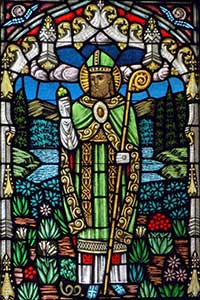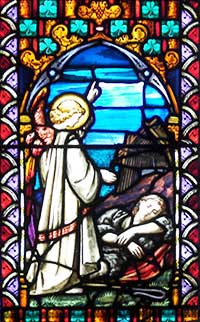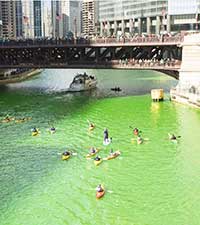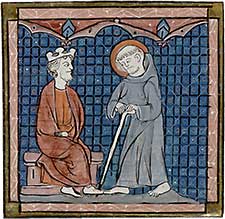Saint Patrick: The Man and the Legend.

What comes to mind when you think of Ireland: Shamrocks? The color green? Guinness? For many, it’s Saint Patrick, Ireland’s patron saint. Yet for all his fame, many of us know little about the man other than his name. So, who was he? And how much of his legend is fact?1
The Setting. Our tale unfolds in the twilight years of the Roman Empire. England is a remote Roman province, where security is a growing concern as legions are being withdrawn to defend mainland frontiers. Christianity is a state-sanctioned religion, after centuries of persecution. Across the sea, Ireland is ruled by rival kings and chieftains. The people follow various local religious sects.
Patrick’s Youth. This was the world that greeted Patrick upon his birth around 389 A.D. in rural Roman Britain. That’s right, the patron saint of Ireland was born in what today is England. Patrick in his own writings sometimes refers to himself as English, other times as Roman. His family were middle-class, Christian landowners. His father, Calpurnius, was a Christian deacon and his grandfather a priest (celibacy wasn’t required until later).

Patrick’s early years were typical for a child of his time and class. But his world changed abruptly at age sixteen when raiders abducted him and others from his family’s estate and took them to Ireland as slaves. Patrick later said his six years of captivity were a punishment for his lack of faith and disregard of the Lord. He prayed a lot and eventually a vision showed him a ship that would take him home. He escaped and made his way to the coast, where he found a ship and eventually persuaded the captain to give him passage.
Patrick then traveled through Europe studying to become a priest. Upon his ordination, he chose to return to Ireland, the land of his captivity, as a missionary. He took to his assignment with zeal and became bishop of Ireland. He is known to have converted many Irish to Christianity, although historical details about his work are lacking.
Shamrocks and Snakes. Images of Patrick usually include a shamrock and snakes at his feet. Such objects are referred to as attributes of a saint and historically were used to identify the saints to parishioners who often couldn’t read.4
Today it is said that Patrick used the three-leaf shamrock to explain the Trinity of God to new Christian converts. Patrick never mentions this in any of his writings, nor are there contemporaneous accounts of shamrocks having being used in that way.

The earliest known connection between Saint Patrick and the shamrock is a 1675 coin showing Patrick holding a shamrock while blessing a congregation.5 A 1681 English traveler, Thomas Dineley, reported seeing Irish celebrants wearing shamrocks on Saint Patrick’s Day.6
Technically, the shamrock is not a plant species, but rather a popular name given to various three-leaved clovers. Although the shamrock is frequently used as a symbol of Ireland and the Irish, it is not actually the country’s official emblem — the harp is.
Patrick’s other attribute, a snake, is tribute to his supposedly having banished them from the island. The story is that Patrick was attacked by snakes while he was fasting on a hilltop. Annoyed, he drove them into the sea, where they perished.
This story would explain why there are, in fact, no snakes in Ireland. Fossil records, however, suggest that there weren’t any for thousands of years before Patrick arrived. National Geographic notes that snakes are slow to spread their habitat, and there has been no natural bridge connecting Ireland with mainland Europe for thousands of years.8

Did Patrick Wear Green? But surely, Patrick must have worn green. It almost seems heretical to suggest otherwise.
But the earliest images of Patrick show him wearing blue, not green. Blue is also the color of the Order of Saint Patrick, established by King George III as an Irish counterpart to the English Order of the Garter, and choristers of Saint Patrick’s Cathedral in Dublin wear blue, not green.10 We have no remnants of Patrick’s own clothing, so we don’t really know what colors he actually wore.
The association of green with Ireland is largely associated with Irish nationalism dated long after Saint Patrick. Irish nationalists adopted a green flag with a harp during a 1641 uprising. In the late 18th century, Irish freedom fighters inspired by the American and French revolutions began wearing green shirts and hats, giving rise to the expression “The Wearing of the Green.” So it seems Saint Patrick is shown in green today because people assume that as an Irish patriot that is what he would have worn, not because there is any evidence that he actually did.11
* * * * *
Looking back, it seems that in some ways the story of Saint Patrick is as much about us as it is about him. The traits we associate with him reflect the beliefs of later generations including our own, not necessarily those of his own time.
-----
- Information for this article comes from: J.B. Bury, The Life of St. Patrick, MacMillan and Co. (1905); and Rachel Moss, The Staff, the Snake and the Shamrock: St Patrick in Art, Saint Patrick’s Confessio web site.
- Window at All Saints Episcopal Church, San Francisco, CA. Image from Wikimedia Commons. More information available at the church’s web site.
- Stained glass window by Michael O’Connor & Co above the main altar at St Patrick’s Church, Monkstown Co Dublin. Image from church’s web site.
- See, Learn About Art, Recognizing Saints: Objects, The National Gallery (UK) web site.
- See, “St. Patrick Coppers 1674-1675 (1681): Introduction,” on the web site of the University of Notre Dame’s Department of Special Collections.
- See, discussion of link to Saint Patrick in Wikipedia article on the Shamrock and Cynthia Collins, Shamrock History as Symbol of Saint Patrick and Ireland, Guardian Liberty Voice web site (March 17, 2014).
- Detail from photo of Chicago River dyed green for Saint Patrick’s Day by Scott M. Liebenson, from Wikimedia Commons (2015).
- James Owen, Did St. Patrick Really Drive Snakes Out of Ireland? National Geographic (March 15, 2014)
- Image of Saint Patrick with King Oengus of Cashel from Jacopo de Voragine’s Legenda Aurea (c 1300) at the Huntington Library, Call Number HM 3027, folio f. 40v.
- See, “Wearing St Patrick’s Blue” on the Modern Medievalism web site (March 18, 2017).
- Olivia B. Waxman, How Green Became Associated With St. Patrick's Day and All Things Irish, Time Magazine (March 16, 2017)
This article originally appeared in our free semi-monthly newsletter. To receive future issues, please add your name to the subscription list.

